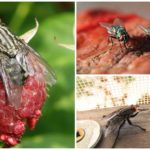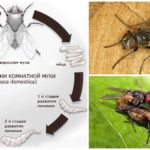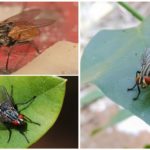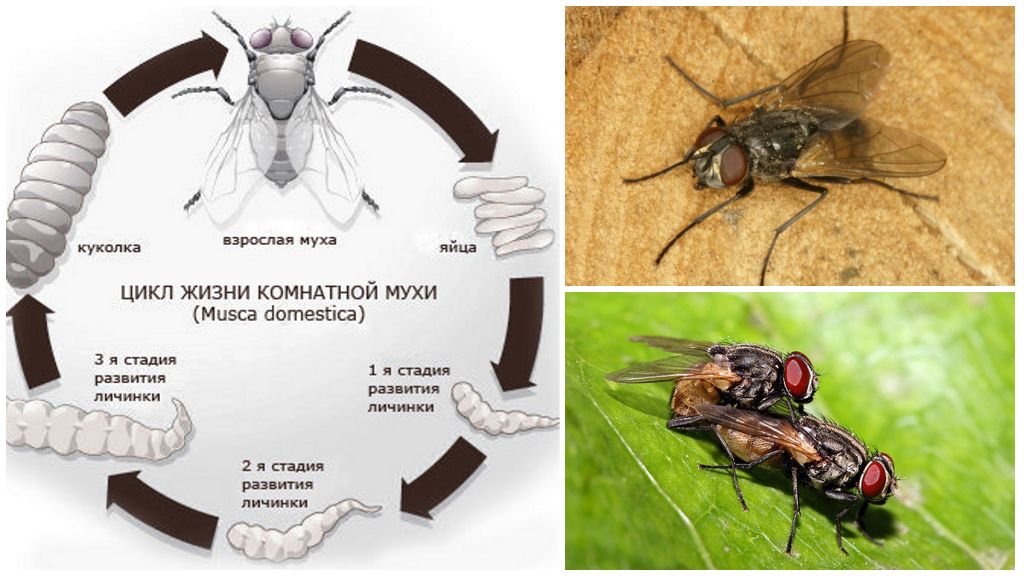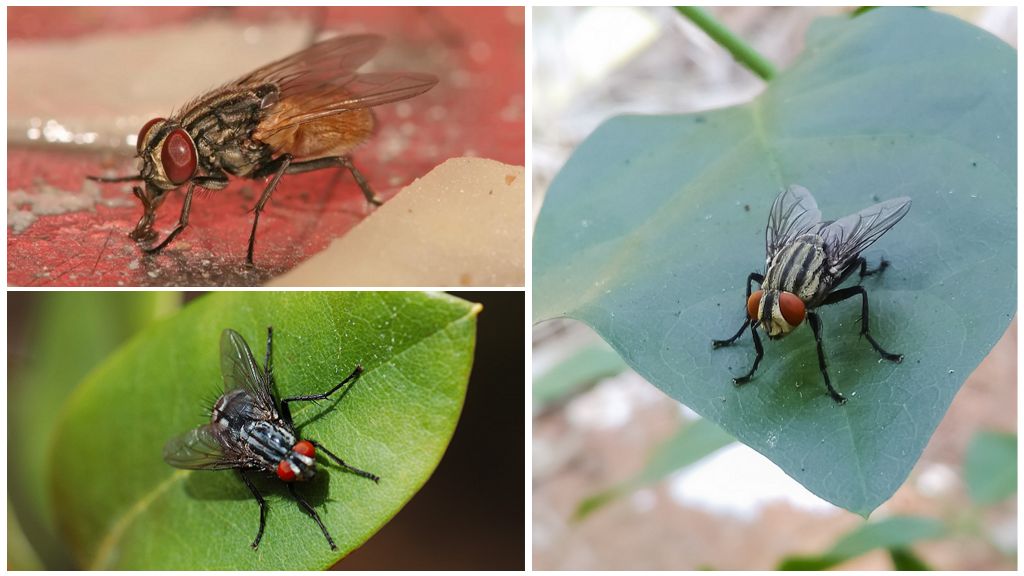Description and photo home flies
- Housefly
- Breeding houseflies
- House fly
The house fly in Latin sounds like Musca domestica. Two-winged insect from a large family real flies. A synanthropic creature practically does not occur in nature, lives side by side with a man. Leads daytime life, multiplies rapidly, is a carrier of dangerous diseases. In Russia, there are 2 species - an ordinary housefly, southern.
Appearance Description
Looks like a fly, they know both rural and urban residents. The structure of the fly can be described as:
- The body size of an adult individual reaches 8 mm.
- The color is gray, closer to black.
- On the upper torso there are 4 longitudinal stripes of black color, the lower part of the abdomen is yellow.
- The surface of the body is covered with numerous thin hairs.
- There are small antennae on the head.
- Well expressed compound eyes, providing broad horizons in different directions. Red-brown color. In females, the distance between the eyes is somewhat wider.
- Two pairs of transparent wings are located along the body. The second pair is underdeveloped - the halter, make a sound during the flight, and also provide air fading.
On a note!
A fly is called a miracle of nature due to its flying ability. During the flight often changes the trajectory of movement, hangs in the air, keeps on the ceiling up legs, without transplants able to overcome 3 km, develops speed up to 6.4 km per hour.
Nutrition
The housefly leads its daytime life, diminishes with the onset of twilight. In the daytime looking for foodlays eggs. House fly - polyphagous, eats mainly liquid food. Favorite dishes - fruit juices, jam, honey, syrup.In severe cases, when there is no other food, eats sugar, cookies, bread crumbs, sweets.
On a note!
Mouth apparatus piercing-sucking, but the human skin can not bite. Room flies do not feed on blood, they do it autumn lighters. Outwardly very similar, so the person does not feel the substitution. Unlike a family relative, the mouth apparatus is equipped with sharp scales that perform the function of teeth, gnaw through the skin of a person, an animal. Minor differences in appearance - the wings spread wide.
The digestive system, as such, no. Digestion of food takes place outside. The same feature is present in the larvae. Initially, the insect sprays a special secret - saliva, which thins food. Then the housefly quietly sucks in the liquid product. It takes more effort to digest solid food, so insects do not like this food very much.
Breeding
The female becomes sexually mature 24-36 hours after leaving the pupa. During the day, lays from 70 to 120 eggs. Laying makes heaps or one at a time. The lifespan of an adult individual is from 8 to 20 days at an air temperature of +20 - +23 degrees Celsius. In some cases, the mature specimen lives up to 60 days.Throughout his life, manages to give life to at least 6 generations.
On a note!
Depending on the climatic conditions, the female lays from 600 to 2000 eggs.
Places for laying - rotten vegetables, fruits, plants, food waste, waste, excrement. Egg size is about 1 mm, even if there is a whole laying, it remains hardly noticeable to humans. Development takes 8-50 hours. Larvae - white worms, which are called maggots. The size of the individuals of the first generation is about 1 mm.
Hatching eggs from the larvae live in a semi-liquid environment, eat the mass in which the female laid eggs. They eat around the clock, grow quickly. They go the way of growing up from 3 to 25 days. During this time, molt three times, increasing in size to 13 mm. After three molting maggots crawls into a dry, dark place, pupates. After 3 days, an imago appears.
Features of life
Up to 20 generations of indoor flies change in a year. With the onset of cold weather, an insect climbs into the cracks, falls asleep. By the end of the summer, they become sleepy, inactive, vulnerable. With the onset of the first frosts disappear altogether. Insect freezes, metabolic processes slow down, the housefly falls asleep.With the onset of the first warm days, with increasing air temperature up to +10 degrees Celsius wakes up, continues to live.
Interesting!
In winter, in a warm room, when a bright sun is shining outside the window, the insect can wake up, get out of the cracks. But for a long time its activity does not last - either the person kills, or falls asleep again.
The homeland of a room or domestic fly is the steppes of Central Asia. This species is widespread. Does not live in the wild nature, lives in the house, apartment, economic premises.
Harm and Benefit
The house flies greatly annoy people with their presence. Their annoying buzz makes you nervous. Worsening the situation is the fact that the pest is difficult to catch, kill. No sooner would a man swipe, as the housefly had already taken off.
However, this is not the only harm. Insects live in an environment that is full of pathogens - feces, slop, garbage cans, rotting products. They carry E. coli on paws, infections, are a distributor of dangerous diseases, worms.
When ingested with food, the larvae can cause a myasis of the internal organs, eyes. Full life cycle the parasite does not pass, but during its presence in the body it causes significant harm. When myasis of the intestine out with vomiting, fecal masses. If the larva continues to develop in the eye, surgery is required, complications are possible, up to a complete loss of vision.
But man has figured out how to make even these flies to benefit. Maggots are used as food for pets - amphibians, fish, lizards, birds. Used as bait for fish. There is a special fishery for breeding maggots in special conditions. After buying live food, keep it in the fridge to prevent pupation.

